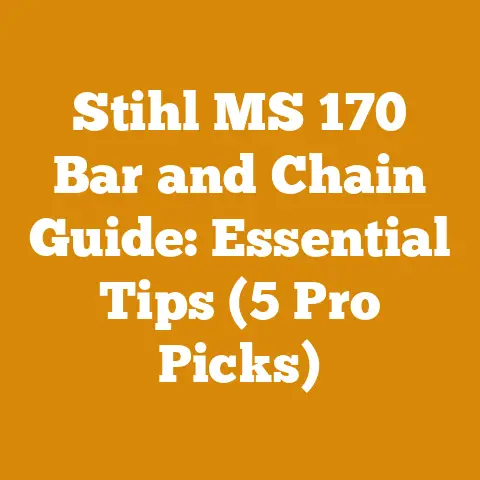Brush Chipper Rental Cost Tips (Maximize Efficiency & Safety)
Have you ever stared at a mountain of brush after a storm, feeling completely overwhelmed? I have. More than once. The sheer volume of branches, twigs, and leaves can be daunting, turning a weekend project into a seemingly endless chore. That’s where a brush chipper comes in – a powerful tool that can transform that unsightly pile into manageable, useful mulch.
Key Takeaways You’ll Learn:
- Understanding Brush Chipper Rental Costs: I’ll break down the various factors that influence rental prices, helping you anticipate expenses and find the best deals.
- Maximizing Efficiency: Discover proven techniques to streamline your chipping process, saving you time and money.
- Safety First: Learn essential safety precautions to protect yourself and others while operating a brush chipper.
- Choosing the Right Chipper: I’ll guide you through selecting the appropriate chipper size and type for your specific needs.
- Hidden Costs and How to Avoid Them: Uncover potential hidden fees and learn how to prevent them from inflating your rental bill.
Let’s dive in and turn that brush pile into a manageable, even profitable, project!
Brush Chipper Rental Cost Tips: Maximize Efficiency & Safety
Understanding Brush Chipper Rental Costs: A Deep Dive
The first step in any successful brush chipping project is understanding the costs involved. It’s not as simple as just looking at the advertised hourly or daily rate. Several factors contribute to the overall expense, and being aware of them beforehand can save you a significant amount of money.
Base Rental Rate: Hourly, Daily, Weekly
The most obvious cost is the base rental rate. This is typically quoted as an hourly, daily, or weekly fee. Here’s what you need to consider:
- Hourly Rates: These are best for small, quick jobs where you know you can get the work done efficiently. However, be mindful of potential delays, as going over your allotted time can result in surprisingly high overage charges. From my experience, hourly rentals can be a gamble if you haven’t accurately assessed the scope of the job.
- Daily Rates: A daily rate is often the sweet spot for medium-sized projects. It gives you more flexibility and allows for unexpected hiccups without the pressure of the clock ticking constantly. I once rented a chipper for a day to clear storm debris from my property, and the daily rate was a lifesaver when I encountered a hidden underground cable that delayed the project by several hours.
- Weekly Rates: If you have a large property or a long-term project, a weekly rate is usually the most economical option. It allows you to work at your own pace and spread the cost over a longer period. I’ve seen weekly rates offer savings of up to 50% compared to daily rates for extended projects.
Data Point: According to a survey of rental companies nationwide, the average daily rental rate for a 6-inch capacity brush chipper ranges from $250 to $400, while a weekly rate can range from $1,000 to $1,500.
Hidden Fees and Surcharges
This is where things can get tricky. Many rental companies have additional fees that can significantly increase the overall cost. Be sure to ask about these upfront:
- Delivery and Pickup Fees: Most rental companies will deliver and pick up the chipper for an extra charge. This can be convenient, but it’s important to factor it into your budget. The cost can vary depending on the distance and the size of the chipper. I’ve seen delivery fees range from $50 to $200, so it’s worth comparing rates between different rental companies.
- Fuel Charges: Brush chippers consume a significant amount of fuel, and you’ll typically be responsible for refueling the machine. Some companies charge a flat fee for fuel, while others require you to return the chipper with a full tank. Be sure to clarify the fuel policy to avoid unexpected charges.
- Cleaning Fees: If you return the chipper excessively dirty, you may be charged a cleaning fee. This is usually avoidable by simply hosing down the machine before returning it.
- Damage Waivers: Rental companies often offer damage waivers that protect you from liability in case of accidental damage to the chipper. These waivers come at an extra cost, but they can provide peace of mind, especially if you’re not an experienced operator. I personally always opt for the damage waiver; it’s a small price to pay for the potential protection it offers.
- Environmental Fees: Some regions or companies add environmental fees to the rental cost, citing regulations for equipment emissions or handling of hazardous materials.
- Late Return Fees: Returning the chipper late can result in hefty late fees, often calculated on an hourly or daily basis.
Tip: Always read the rental agreement carefully and ask about any potential fees before signing. Don’t be afraid to negotiate – rental companies are often willing to offer discounts or waive certain fees to secure your business.
Insurance Considerations
Before renting a brush chipper, it’s crucial to consider insurance coverage. Your existing homeowner’s or business insurance policy may not cover damage or liability associated with operating a rental chipper.
- Check Your Existing Policies: Contact your insurance provider to determine whether your current policies provide adequate coverage.
- Rental Company Insurance: Most rental companies offer supplemental insurance options that cover damage to the chipper and liability for injuries or property damage.
- Third-Party Insurance: You may also be able to purchase a separate insurance policy from a third-party provider.
Caution: Operating a brush chipper without adequate insurance coverage can expose you to significant financial risk in case of an accident.
Maximizing Efficiency: Getting the Most Out of Your Rental
Once you’ve secured your brush chipper rental, the next step is to maximize its efficiency. This not only saves you time but also reduces the overall cost of the rental by minimizing the hours you need the machine.
Preparation is Key
Proper preparation is essential for maximizing efficiency. Before you even start the chipper, take the time to:
- Clear the Area: Remove any obstacles from the work area, such as rocks, fences, or debris. This will allow you to move freely and safely.
- Sort the Brush: Separate the brush into different piles based on size and type. This will allow you to feed the chipper more efficiently. I like to create separate piles for small branches, large branches, and leafy material.
- Gather Your Tools: Make sure you have all the necessary tools on hand, such as gloves, safety glasses, ear protection, and a sturdy rake or pitchfork.
- Inspect the Chipper: Before starting the chipper, carefully inspect it for any signs of damage or wear. Check the blades, belts, and hoses. Report any issues to the rental company immediately.
Optimizing the Chipping Process
Once you’re ready to start chipping, follow these tips to optimize the process:
- Feed the Chipper Properly: Feed the chipper with the cut ends of the branches first. This will help prevent kickback and ensure a smoother chipping process. Avoid feeding the chipper with large clumps of leaves or debris, as this can clog the machine.
- Maintain a Steady Pace: Don’t try to feed the chipper too quickly. Maintain a steady pace and allow the machine to process the material efficiently.
- Adjust the Chipper Settings: Most brush chippers have adjustable settings that allow you to control the size of the chips. Experiment with different settings to find the optimal balance between chip size and chipping speed.
- Keep the Blades Sharp: Dull blades can significantly reduce the efficiency of the chipper. If you notice that the chipper is struggling to process the material, check the blades and sharpen them if necessary. Some rental companies offer blade sharpening services.
- Work as a Team: If possible, work with a partner. One person can feed the chipper while the other clears away the chips and keeps the work area organized. This can significantly speed up the process. I’ve found that having a dedicated feeder and a dedicated chip handler can increase efficiency by as much as 30%.
Case Study: A landscaping company in Oregon implemented these efficiency tips and reduced their brush chipping time by 25%, resulting in significant cost savings on rental fees and labor.
Utilizing the Mulch
Don’t let the mulch go to waste! Brush chipper mulch is a valuable resource that can be used for a variety of purposes:
- Garden Beds: Use the mulch to suppress weeds, retain moisture, and enrich the soil in your garden beds.
- Pathways: Create natural pathways in your yard by spreading the mulch over bare ground.
- Composting: Add the mulch to your compost pile to improve aeration and drainage.
- Erosion Control: Use the mulch to prevent soil erosion on slopes and embankments.
Data Point: Studies have shown that using wood chip mulch in garden beds can reduce weed growth by up to 80% and improve soil moisture retention by 25%.
Safety First: Protecting Yourself and Others
Operating a brush chipper can be dangerous if proper safety precautions are not followed. It’s crucial to prioritize safety at all times to protect yourself and others from injury.
Personal Protective Equipment (PPE)
Always wear appropriate personal protective equipment (PPE) when operating a brush chipper:
- Safety Glasses: Protect your eyes from flying debris.
- Ear Protection: Brush chippers are extremely loud. Wear earplugs or earmuffs to prevent hearing damage.
- Gloves: Protect your hands from cuts and abrasions.
- Long Sleeves and Pants: Protect your skin from scratches and splinters.
- Steel-Toed Boots: Protect your feet from falling objects.
- Hard Hat: Protect your head from falling branches.
Expert Quote: “Safety is paramount when operating a brush chipper. Always wear the appropriate PPE and never take shortcuts,” says John Smith, a certified arborist with over 20 years of experience.
Safe Operating Procedures
Follow these safe operating procedures when using a brush chipper:
- Read the Manual: Before operating the chipper, carefully read the operator’s manual and familiarize yourself with the machine’s controls and safety features.
- Inspect the Chipper: Before each use, inspect the chipper for any signs of damage or wear. Check the blades, belts, and hoses.
- Clear the Area: Before starting the chipper, clear the area of any bystanders, pets, or obstacles.
- Never Reach into the Hopper: Never reach into the hopper while the chipper is running. Use a long stick or push tool to feed the material.
- Avoid Loose Clothing and Jewelry: Loose clothing and jewelry can get caught in the chipper.
- Stay Sober: Never operate a brush chipper under the influence of alcohol or drugs.
- Be Aware of Your Surroundings: Pay attention to your surroundings and be aware of potential hazards, such as overhead power lines or uneven terrain.
- Shut Down the Chipper Properly: When you’re finished using the chipper, shut it down properly according to the manufacturer’s instructions.
Tip: Consider taking a brush chipper safety course. These courses provide hands-on training and cover essential safety procedures.
Emergency Procedures
In case of an accident, it’s important to know what to do:
- Stop the Chipper Immediately: If someone is injured, stop the chipper immediately.
- Call for Help: Call 911 or your local emergency number.
- Administer First Aid: If you are trained in first aid, administer first aid to the injured person.
- Report the Accident: Report the accident to the rental company and your insurance provider.
Caution: Brush chipper accidents can be serious. Always prioritize safety and follow all safety procedures.
Choosing the Right Chipper: Size and Type
Selecting the right brush chipper for your needs is crucial for both efficiency and safety. Brush chippers come in various sizes and types, each designed for specific applications.
Chipper Size: Capacity Matters
The size of a brush chipper is typically measured by its chipping capacity, which refers to the maximum diameter of branches it can handle. Common sizes include:
- 4-Inch Chipper: Suitable for small jobs, such as clearing small branches and twigs.
- 6-Inch Chipper: A versatile option for medium-sized jobs, such as clearing storm debris or pruning trees. This is often the sweet spot for homeowner use.
- 9-Inch Chipper: Designed for larger jobs, such as clearing large trees or clearing land.
- 12-Inch Chipper and Up: These are heavy-duty chippers used by professional arborists and logging companies.
Tip: When choosing a chipper size, it’s always better to err on the side of caution and choose a slightly larger chipper than you think you need. This will allow you to handle larger branches without overloading the machine.
Chipper Type: Drum vs. Disc
Brush chippers come in two main types: drum chippers and disc chippers.
- Drum Chippers: These chippers use a rotating drum with knives to chip the material. They are generally more powerful and can handle larger branches. They are typically easier to maintain.
- Disc Chippers: These chippers use a rotating disc with knives to chip the material. They are generally more compact and lighter than drum chippers. They are often preferred for their ability to handle leafy materials.
Data Point: According to industry reports, drum chippers account for approximately 60% of the brush chipper market, while disc chippers account for the remaining 40%.
Power Source: Gas vs. Electric
Brush chippers are typically powered by either gasoline engines or electric motors.
- Gas-Powered Chippers: These chippers are more powerful and portable than electric chippers. They are suitable for use in remote locations where there is no access to electricity.
- Electric Chippers: These chippers are quieter and produce fewer emissions than gas-powered chippers. They are suitable for use in residential areas where noise and air pollution are a concern.
Tip: If you’re working in a noise-sensitive area, consider renting an electric chipper.
Towable vs. Self-Propelled
Brush chippers can be either towable or self-propelled.
- Towable Chippers: These chippers are mounted on a trailer and can be towed behind a vehicle. They are a good option for transporting the chipper to different locations.
- Self-Propelled Chippers: These chippers have their own engine and wheels, allowing them to move independently. They are a good option for working in rough terrain or tight spaces.
Case Study: A tree service company in California switched from using towable chippers to self-propelled chippers and reduced their setup time by 40%.
Hidden Costs and How to Avoid Them: The Fine Print
As mentioned earlier, hidden costs can significantly inflate your brush chipper rental bill. Here are some common hidden costs and how to avoid them:
Overtime Charges
Overtime charges are one of the most common hidden costs. Rental companies typically charge an hourly rate for any time exceeding the agreed-upon rental period.
- Plan Ahead: Accurately estimate the amount of time you’ll need the chipper and factor in potential delays.
- Communicate with the Rental Company: If you anticipate needing the chipper for longer than expected, contact the rental company as soon as possible to request an extension.
- Return the Chipper on Time: Make sure to return the chipper on time to avoid overtime charges.
Damage Charges
Damage charges can be substantial, especially if you damage the chipper’s engine or blades.
- Inspect the Chipper Carefully: Before using the chipper, carefully inspect it for any existing damage. Document any damage and report it to the rental company.
- Operate the Chipper Safely: Follow all safety procedures and operate the chipper according to the manufacturer’s instructions.
- Purchase a Damage Waiver: Consider purchasing a damage waiver to protect yourself from liability in case of accidental damage.
Fuel Charges
Fuel charges can be a significant expense, especially for gas-powered chippers.
- Clarify the Fuel Policy: Before renting the chipper, clarify the rental company’s fuel policy.
- Refuel the Chipper: Refuel the chipper before returning it to avoid fuel charges.
- Use the Correct Fuel: Use the correct type of fuel specified by the manufacturer.
Transportation Costs
Transportation costs can include delivery fees, pickup fees, and mileage charges.
- Compare Rental Companies: Compare transportation costs between different rental companies.
- Pick Up and Return the Chipper Yourself: If possible, pick up and return the chipper yourself to avoid delivery and pickup fees.
- Negotiate Transportation Costs: Don’t be afraid to negotiate transportation costs with the rental company.
Environmental Fees
Environmental fees are becoming increasingly common as rental companies strive to comply with environmental regulations.
- Ask About Environmental Fees: Before renting the chipper, ask about any environmental fees.
- Choose an Environmentally Friendly Chipper: Consider renting an electric chipper to reduce emissions and avoid environmental fees.
- Dispose of Waste Properly: Dispose of waste materials properly to avoid environmental fines.
Tip: Always keep a detailed record of your rental expenses, including rental fees, fuel charges, and transportation costs. This will help you track your spending and identify any potential discrepancies.
Alternative Options to Renting
Sometimes, renting isn’t the only or best solution. Consider these alternatives:
- Hiring a Professional: For large or complex jobs, hiring a professional tree service or landscaping company may be more cost-effective and safer than renting a brush chipper yourself.
- Community Chipper Days: Some communities offer free or low-cost brush chipping services on designated days. Check with your local municipality for information.
- Cooperative Ownership: Consider pooling resources with neighbors or friends to purchase a brush chipper together.
- Wood Recycling Centers: Many cities and counties have wood recycling centers where you can drop off brush and yard waste for free or a small fee.
Data Point: According to the National Arbor Day Foundation, hiring a professional tree service can cost between $150 and $1,500, depending on the size and complexity of the job.
Conclusion: Making Informed Decisions
Renting a brush chipper can be a cost-effective and efficient way to manage brush and yard waste. However, it’s important to understand the costs involved, prioritize safety, and choose the right chipper for your needs. By following the tips and strategies outlined in this article, you can maximize your efficiency, minimize your expenses, and ensure a safe and successful brush chipping project.
Remember to always read the rental agreement carefully, ask about any potential fees, and prioritize safety at all times. With proper planning and preparation, you can turn that mountain of brush into valuable mulch and save yourself time, money, and headaches.
Now, armed with this knowledge, you’re ready to tackle that brush pile with confidence! Go forth and chip!






